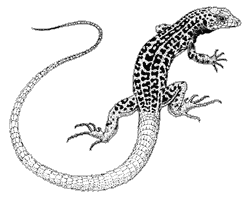Whiptails
(Aspidoscelis spp.)
Order: Squamata
Family: Teiidae (whiptails)
Other common name: racerunner
Spanish name: huico
Distinguishing Features
Whiptails are long, slender lizards with pointed snouts and extremely long tails. Snout-vent lengths range from 2¾ inches (69 mm) to 5¼ inches (137 mm) among the various species of whiptails. Giant spotted whiptails (C. burti), with tails longer than their bodies, can have a total length of over a foot. Color tends to be tan, olive, or brown with lighter stripes and/or spots of yellow or white. Male western whiptails (C. tigris) may have very dark forelimbs, throats and upper torsos. Whiptails have large, square belly scales arranged lengthwise and transverse rows. The scales on the upper part of the body are very small and granular in appearance.

Western whiptail
Range
Whiptails are found throughout the Sonoran Desert region from sea level up to 8000 feet (2440 m).
Habitat
These lizards occupy low desertscrub through grasslands, woodlands and pine forests. They are often found under rocks or nosing around leaf litter.
Life History
Whiptails feed on a variety of terrestrial invertebrates and occasionally on smaller lizards. Most species reproduce sexually and lay 1 or more clutches of 1 to 6 eggs in late spring or early summer. However, in Arizona approximately 60 percent of whiptail species are parthenogenetic, meaning that they reproduce asexually. These species, such as the Sonoran spotted whiptail (C. sonorae), consist entirely of genetically identical females that lay unfertilized eggs, creating a population of clones. Oddly enough, many of the behaviors exhibited by sexually reproducing species are expressed by these parthenogenetic lizards. Females will engage in pseudocopulation and mount and bite other females. Apparently this triggers hormonal changes necessary for ovulation and egg laying. Eggs typically take 60 to 75 days to hatch regardless of reproductive style.
Comments
Lizards’ behavioral habits vary considerably. Some are day active. Others, such as most geckos, are nocturnal. Some are sit-and-wait predators, while others are active foragers. Whiptails fit the latter description in the extreme. Beyond actively foraging, they forage intensely for prey, often at a frenetic pace.
When they are on the move under plants or through leaf-litter, their jerky, start-stop movements create unmistakable and unique sounds. Someone familiar with whiptail lizards can often locate and identify a whiptail from auditory cues alone.
Lizard Displays
Most Sonoran Desert lizards use a variety of behaviors in a purely social context. Displays to establish dominance or territory or to aid in courtship are common. Though many species are similar in their behavioral repertoires, each species’ behaviors are unique to that species. They may differ only slightly, such as with head-bobs, where the number of or intensity of them may be the only difference. Then again, some are vastly different. The open-mouthed gape and vertical extension of the body and throat of collared lizards, which serve as a challenge from one male to another, appear quite different from the four-legged push-ups accompanied by the display of the brightly colored dewlap of tree lizards, though both serve the same purpose.
Some of these displays are used only within a species, while others may be used between species. Aggressive male collared lizards will display to establish dominance over just about any other lizard they can intimidate. Often, agonistic (aggressive) behaviors are ritualized display between males. These behaviors serve to reduce physical contact and the potential for injury to either animal.
An inventory of a species’ repertoire may include gaping, lunging, chasing, biting, inflation of the body or throat, head bobs, and push-ups, as well as subtler shudders of the body. Some of these actions will be used only between males, while others facilitate courtship. What may superficially resemble agonistic push-ups may actually be a subtler shudder of the fore-body, which a male uses to court a female.
Taking a closer look at how lizards interact with one another can be fascinating entertainment, as well as a way to give the observer a better understanding of how animals that cannot speak actually communicate desire, intent, and need to each other.